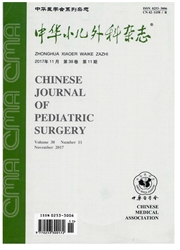

 中文摘要:
中文摘要:
目的应用同位素标记的绝对和相对定量(isobarictagsforrelativeandabsolutequantitation,iTRAQ)技术筛选并鉴定不同预后的胆道闭锁患儿肝脏中表达的差异蛋白质,并进行生物信息学分析。方法收集Ⅲ型胆道闭锁患儿Kassi手术时肝脏组织,术后对患儿预后进行随访,根据3个月时黄疸是否消退和自体肝存活时间,将标本筛选并分为两组,预后较好组(术后3个月时血清总胆红素≤25μmol/L,自体肝存活时间≥2年)和预后较差组(术后3个月时血清总胆红素〉25μmol/L,自体肝存活时间〈1年),每组患儿标本各10例。将样本经iTRAQ标记和液相色谱分离后,用质谱仪进行鉴定和相对定量分析,对获得的差异蛋白进行PANTHER分类和生物功能分析,并对差异表达的蛋白Mx1进行了Western-blot验证。结果经质谱鉴定共获得蛋白5177个,其中差异表达倍数大于1.5倍的蛋白共323种,包括在预后较好组上调的蛋白131种和在预后较差组上调的蛋白192种。经PANTHER蛋白分类和功能分析,差异表达的蛋白主要涉及代谢过程、免疫过程等14个生物过程。其中在预后较好组差异表达倍数前10位的上调蛋白,几乎全部参与了病毒感染后的免疫应答过程。结论iTRAQ技术能够快速、有效地进行肝脏差异蛋白质组学的研究,能筛选出多种与胆道闭锁病因和预后相关的蛋白,为进一步研究胆道闭锁发病机制提供了实验依据。
 英文摘要:
英文摘要:
Objective To identify and quantify total proteins in liver tissue of patients with biliary atresia (BA) by isobaric tags for relative and absolute quantification (iTRAQ) technology to decipher the relationship between significant protein and its prognosis. Methods According to the serum level of total bilirubin (TBIL) in 3 months and native liver survival time (NLST), the patients were divided into 2 groups of good prognosis (3M TBIL≤25 /1tool/L, NLST〉2 years) and poor prognosis (3M TBIL〉25 μmol/L, NLST〈 1 year) (n = l0 each). Liver tissues were collected during Kasai operation. And iTRAQ technique was used to identify and quantify the expression of differential proteins. Then differential proteins were classified by Panther classification system. The results were further validated by Western blot. Results A total of 5177 proteins were identified by mass spectrometry. Among them,323 differential proteins with expression folds of over 1.5 were identified. Among these proteins, as compared with poor prognosis group, 131 proteins were up-regulated and ] 92 proteins down-regulated in good prognosis group. These differential proteins were related with 14 kinds of biological processes (e. g. metabolic and immune system). Conclusions The technique of iTRAQ is effective for comparative proteomic studies. Thus these identified differential proteins will provide further clues for studying the pathogenesis and prognosis of BA.
 同期刊论文项目
同期刊论文项目
 同项目期刊论文
同项目期刊论文
 Initial Experience of Single-Incision Laparoscopic Hepaticojejunostomy Using Conventional Instrument
Initial Experience of Single-Incision Laparoscopic Hepaticojejunostomy Using Conventional Instrument Conditional probability of survival in patients with biliary atresia after Kasai portoenterostomy: a
Conditional probability of survival in patients with biliary atresia after Kasai portoenterostomy: a 期刊信息
期刊信息
